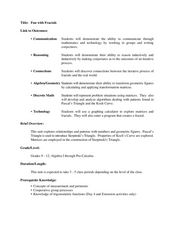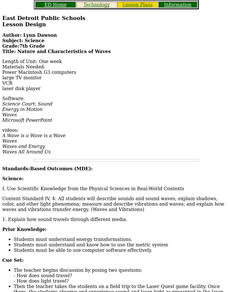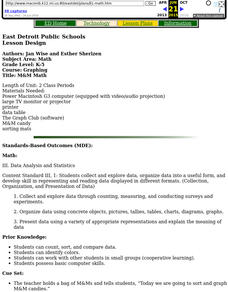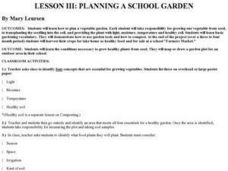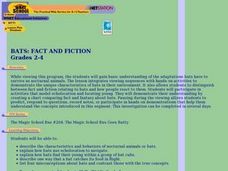Curated OER
A Sense of Community
Students brainstorm characteristics they associate with a community. In groups, they discover the role of a town square and create their own model. They also identify the various roles in keeping the community going and role play their...
Curated OER
Friction and Gravity
Seventh graders identify the factors that determine the strength of the friction forces when two objects push against each other. Describing the difference between weight and mass, they participate in experiments. They state the law of...
Curated OER
Nuclear Fleas
Seventh graders distinguish characteristics of living things and identify the importance of careful observation. They identify five things that are not alive, but display characteristics of life and list five things that are alive, but...
Curated OER
Age of Exploration: A Comprehensive Research Project
Fifth graders examine reasons for exploration, the outcomes, and various explorers. In this age of exploration lesson, 5th graders create a flipbook with timeline and images to showcase their knowledge.
Curated OER
Fun With Fractals
Young scholars use fractals to analyze nature. In this geometry lesson, students work in groups using technology and math to communicate. They identify where in the real world fractal can be seen.
Curated OER
Paper Airplane Activity
Ninth graders select and build one of five different paper airplane designs and test them for distance and for time aloft. Part of this activity is designed to explore NASA developed software, FoilSim, with respect to the lift of an...
Curated OER
Nature and Characteristics of Waves
Seventh graders research different types of waves, identify the parts of a wave and create a Power Point presentation demonstrating what they have learned.
Curated OER
M&M Math
Pupils sort a bag of M&M candies according to color using a sorting mat. They count M&M candies. They compare the number to their prediction then students create tally charts.
Curated OER
Planning A School Garden
Students discover how to plan a vegetable garden. Each student take responsibility for growing one vegetable from seed, to transplanting the seedling into the soil, and providing the plant with light, moisture, temperature and healthy soil.
Curated OER
Counting Coins
Learners identify the different types of coins. They practice buying objects in the classroom with their coins. They must use different combinations of coins in all situations.
Curated OER
Interpreting Company Accounts
Students look at the two aspects of interpreting company accounts. They can be closely related to each other. Depreciation is investigated and is interpreted according to the inquiry made. The affect of how accounts are presented is...
Curated OER
Clouds and the Weather
Fourth graders analyze the relationship of clouds and local weather. Students also observe and record cloud data and weather conditions daily as they research different cloud types. The data is analyzed looking for trends in daily...
Curated OER
Atomic Structure and Quantum Theory
Students are introduced to the structure of an atom and Dalton's atomic theory through a short video and mini-lecture. They also take a look at the weight of mass and become familiar with the idea of quantum theory
Curated OER
Simple Machines In Action
Students name and recognize six types of simple machines. They use their research to design an amusement park ride that features different types of simple machines. Students create a brochure about their ride and how it works. Simple...
Curated OER
Cause and Effect
Students identify cause and effect relationships in a short story. After reading a short story, they participate in a discussion of how one event in a story can lead to several others. Students are then paired for a matching task that...
Curated OER
Area of Complex Figures
Fifth graders use formulas for calculating areas of squares and rectangles to find area of complex figure, compare their own ideas with their classmates' ideas, and recognize that there are multiple methods for finding area of complex...
Curated OER
Bats: Fact and Fiction
Students describe the characteristics and behaviors of bats. After viewing a video, they explain how bats use echolocation to navigate and how they find their young within a group. They list four misconceptions about the animal and...
Curated OER
A Matter of Fact
Third graders define matter as anything that takes up space and has mass, recognize, through experimentation and observation, that matter exists in three forms, including solid, liquid, and gas, and discuss characteristics of each form...
Curated OER
Time Conceptualization
Students relate the number and length of generations in their living family members to the number of generations that have passed since specific events in recorded history. They then apply this time conceptualization to the number of...
Curated OER
What Does It Matter?
Students define matter, the chemical properties of matter, and the physical properties of matter. They name physical and chemical properties of matter (by classifying using a Tree Map). Students determine the mass, volume, and density of...
Curated OER
Food Foldable
Second graders read the poem, "Balanced Diet" and cut out the food foldable inserts. They fold the food foldable in half and cut on the dotted lines. They then unfold the food foldable and weave through inserts through the openings,...
Curated OER
It's a Fact!
Second graders investigate the concept of addition and subtraction while manipulating a variety of different resources. They focus upon the use of the games in order to keep student engagement. Then students are given the opportunity to...
Curated OER
Let's Find Out About Money
First graders investigate the uses and development of money as part of the study of finance. They focus upon the recognition of different coins and identify the value of each. Then students solve problems involving money and coins.
Curated OER
Lesson plan: Archaeology - Its Methods and Use
Students study the field of archeology. In this archeology instructional activity, students participate in 12 activities that require them to examine archeology, garbology, artifacts, ethical issues, and field specific vocabulary.






